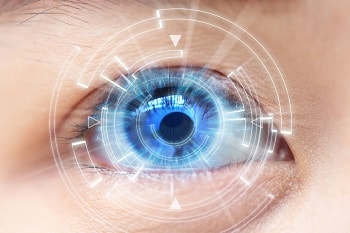When people think of workplace dangers to the eyes, it is usually machinery, chemicals or construction materials that come to mind. However, a growing danger to the eyes is one that may be less obvious – exposure to blue light from digital devices, television and computer screens and artificial lighting. 
While the long-term effects of blue light or high-energy visible (HEV) light emission are not yet fully known, what is known is that blue light is a cause of computer vision syndrome (CVS) and sleep disruptions. 60% of people spend more than 6 hours a day in front of a digital device and 70% of adults report some symptoms of computer vision syndrome (CVS) which include eyestrain, headaches, blurred or double vision, physical and mental fatigue, dry or watery eyes, difficulty focusing, sensitivity to light, or neck, shoulder or back pain (caused by compromised posture to adjust to vision difficulty). Most people do nothing to ease their discomfort from these symptoms because they are not aware of the cause.
In its natural form, blue light from the sun is actually beneficial to your body by helping to regulate your natural sleep and wake cycles – also known as your circadian rhythm. It can also boost your mood, alertness and overall feeling of well-being. However, prolonged exposure to artificial sources of blue light, such as that found in electronic devices, television and energy-efficient fluorescent and LED lights, has been shown to cause disruptions in the circadian rhythm as well as more serious vision problems. Researchers at Harvard University have linked blue light with damage to the retina at the back of your eyes, indicating that long-term exposure to blue light could be linked to age-related macular degeneration (AMD) and possibly other serious health and vision problems.
Since 43% of adults work at jobs that require prolonged use of a computer, tablet or other digital monitor, blue light is an increasingly serious threat to your vision, health and productivity. There are a number of options for reducing your exposure to blue light which include computer glasses, specialized lenses and protective coatings. Speak to our eye care professionals to determine which option is best for you.
- Single Vision Computer Glasses: Provide the optimum lens power and field of view for viewing your computer screen without straining or leaning in to reduce symptoms of CVS. These are ideal for when the computer is at a fixed working distance, and work well if the user needs to view multiple screens at the same working distance.
- Office Lenses or Progressive Lenses: No-line multifocal eyewear that can be made to correct near, intermediate and some distance vision with a larger intermediate zone for computer vision if indicated. Perfect for those with presbyopia which is the gradual loss of focusing ability that occurs naturally with age. Office lenses work like progressive lenses but provide a wider field of view for intermediate (1-3 m) viewing distance and near working distance (about 40 cm).
- Blue-Blocking Lenses: Definitely recommended for this electronic age, blue-blocking lenses block blue light emitted from computer screens that is associated with glare, eye strain and possible sleep disturbances.
- Anti-glare and filtering coatings (treatments): Eliminate reflections from the surfaces of your lens to reduce eye strain and discomfort from glare. Some coatings can also block blue light emitted from computer screens.
Additionally, diets high in lutein and zeaxanthin, which are carotenoids found in dark, leafy green vegetables like spinach and kale are protective to blue light damage.
A note about children and blue light:
Children are more prone to blue light damage than adults because the natural lenses in their eyes are so clear that blue light passes easily through to reach the retina. Adults are somewhat less prone since the older we get our natural lenses become more cloudy and blue light does not pass through quite as easily. Pediatricians recommend that young children under the age of two should get ZERO screen time. They have much better ways of developing their eyesight with activities requiring hand eye coordination with high contrast physical objects.
Technology is advancing the world, and our jobs and daily lives will only continue to rely upon it. Don’t let technology get in the way of your vision and your health. Ask us about the best solution for you.
As we spend more time on electronic devices, we must take our vision into account. Talk to your optometrist about how much you use electronic devices during your daily work routine so that he or she may make recommendations to reduce the effects of digital eye strain.
- Make sure your screen is 20-26 inches from your face and a little bit below eye level
- Enlarge the text for more comfortable reading
- Follow the 20-20-20 rule, look at something 20 feet away for 20 seconds every 20 minutes of screen time
- Take frequent breaks and give your eyes a rest from the screen
- Remember to blink as sometimes looking at electronic devices for extended periods of time makes you blink less often and causes your eyes to become dry and irritated
It is important to schedule regular eye exams with your optometrist. Comprehensive eye exams are a great way to keep tabs on your eye health. Be sure to mention to your optometrist any potential work-related hazards so that your optometrist helps you prevent injury.
References
- Workplace Eye Wellness: The Dangers of Blue Light May 09, 2017
Make your appointment today
To make your appointment, simply give us a call (760)-948-3345 or
or
Due to COVID-19 safety protocols, all eyewear services are currently by appointment only. Please call to make an appointment.
At Golden Eye Optometry, we view good vision care as front line protection at every age. A routine eye exam can detect more than poor vision. It can shed early light on glaucoma, macular degeneration, cataracts and diabetes.